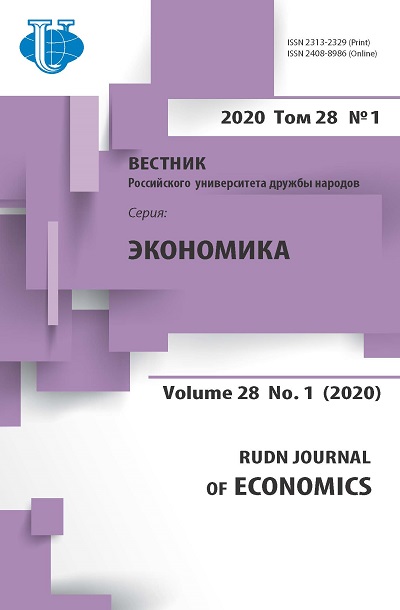China - EU: legal framework and trade cooperation at the present stage
- Authors: He M.1
-
Affiliations:
- Kunming Polytechnic University
- Issue: Vol 28, No 1 (2020)
- Pages: 72-82
- Section: GLOBALIZATION AND ECONOMIC INTEGRATION
- URL: https://journals.rudn.ru/economics/article/view/23494
- DOI: https://doi.org/10.22363/2313-2329-2020-28-1-72-82
Cite item
Full Text
Abstract
Relations between the EU and China are of global importance, and these ties are likely to expand in the coming years. Analyzing the trade relations between the EU and China in 2009-2018, the author notes their activation and at the same time the growth of instability and imbalance. The main purpose of this article is to answer the question, what are the success factors and problems of cooperation in the field of mutual trade, in order to identify the conditions that can play an important role in the process of strengthening bilateral ties between China and the European Union. According to the author, China and the European Union, taken together, can become engines of a more cooperative approach to world politics, global stability and regional economic prosperity.
Keywords
About the authors
Mingjun He
Kunming Polytechnic University
Author for correspondence.
Email: minzun.xe@yandex.ru
Ph.D. in Economics, senior lecturer of Faculty of Law
727 Qingming nanlu St., Chengdong district, Kunming, People's Republic of ChinaReferences
- Aoyama, R. (2016). One Belt, One Road: China’s new global strategy. Journal of Contemporary East Asia Studies, 5(2), 3–22.
- COM. (1995, July 5). 279 final: Communication of the Commission “A Long-Term Policy for China – Europe Relations”. Brussels. Retrieved from europa.eu.int/comm/external_ relations/china/ com95_279en.pdf
- COM. (2001, May 15). 265 final: Communication from the Commission to the Council and the European Parliament “EU Strategy towards China: Implementation of the 1998 Communication and future steps for a more effective EU policy”. Brussels. Retrieved from https://eur-lex.europa.eu/LexUriServ/LexUriServ.do?uri=COM:2001:0265:FIN:EN:PDF
- COM. (2003, October 10). 533 final: Commission policy paper for transmission to the Council and the European Parliament “A maturing partnership – shared interests and challenges in EU – China relations”. Brussels. Retrieved from https://eur-lex.europa.eu/ legal-content/EN/TXT/PDF/?uri=CELEX:52003DC0533&rid=2
- COM. (2006, October 24). 632 final: Communication from the Commission “EU – China: Closer Partners, Growing Responsibilities”. Brussels. Retrieved from https://eur-lex. europa.eu/LexUriServ/LexUriServ.do?uri=COM:2006:0631:FIN:EN:PDF
- Freund, C., & Omelas, E. (2010). Regional Trade Agreements. Washington, D.C.: The World Bank.
- Gladkov, I.S. (2019). Foreign trade of the European Union 2018: presto with tulips. Power, 27(3), 161–166.
- Gladkov, I.S., & Dubovik, M. (2018). Current trends in the economy and foreign trade of the EU at the stage of sanctions. Azimuth of scientific research: Economics and management, 7(1–22), 95–98.
- He, M. (2019). China – EU commodity trade in 2018: main trends and results. Russia and Asia, (8), 22–32.
- Kamiński, T. (2019). What are the factors behind the successful EU – China cooperation on the subnational level? Case study of the Lodzkie region in Poland. Asia Europe Journal, (17), 227–242.
- Korzhengulova, A., Shkvarya, L., & Melanyina, M. (2017). The EU – Russia conceptual interaction in the Eurasian space in the context of western sanctions. Central Asia and the Caucasus, 18(1), 7–14.
- Mardashev, A.A. (2009). Prospects for the conclusion of the first comprehensive agreement between the EU and China – the agreement on partnership and cooperation. Vestnik Rossiyskogo Universiteta Druzhby Narodov. Series: International relations, (2), 10–18.
- Mazyrin, V. (2017). Economic patterns and performance of Indochina nations. International Trends, 15(3–50), 25–37.
- Nosov, M.G. (2018). EU and China: trade or strategy. Modern Europe, 6(85), 5–18.
- Panagravia, A. (2002). EU Preferential Trade Arrangements and Developing Countries. The World Economy, 25(10), 1415–1432.
- Pavlićević, D. (2019). Structural power and the China – EU – Western Balkans triangular relations./ Asia Europe Journal, 17(4), 453–468.
- Pew Research Center. (2018, July 14). http://www.pewglobal.org/2014/07/14/chapter-3-balanceof-power-us-vs-china/
- Rusakovich, V.I., & Nezhelskaya, A.V. (2014). India and China: experience of joining the WTO. Today and tomorrow of the Russian economy, (63), 59–60.
- Savinskiy, A.V. (2004). Problems and basic models of regionalism in the world economy. Moscow. Savinskiy, A.V. (2017). Foreign trade of China and cooperation with Russia. Russia and Asia, (1), 44–49.
- Shkvarya, L., Grigorenko, O., Strygin, A., Rusakovich, V., & Shilina, S. (2016). Vliyanie globalnogo economicheskogo krizisa na tekhnologicheskie rynki stran Azii (Indiya, Kitay) [The impact of the global economic crisis on Asian technology markets (India and China)]. Centralnaya Aziya i Kavkaz, 19(2), 119–130.
- Solov'eva, Yu.V. (2014). Organizational features of technology transfer: foreign experience. Bulletin of Peoples’ Friendship University of Russia. Series: Economics, (3), 136–146.
- Summers, T. (2016). China’s ‘new silk roads’: sub-national regions and networks of global political econom. Third World Quarterly, 37(9), 1628–1643.
- Tian, I. (2019). Sino-Russian trade cooperation: a new impetus to development. Russia and Asia, (7), 22–30.
- UNCTAD (United Nations Conference on Trade and Development). Statistics. Retrieved from http://unctadstat.unctad.org















